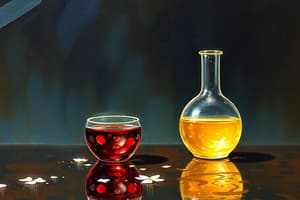Podcast
Questions and Answers
Which of the following statements accurately describes a chemical reaction at equilibrium?
Which of the following statements accurately describes a chemical reaction at equilibrium?
- All reactants have been converted into products, resulting in a static system.
- The forward reaction has ceased, and only the reverse reaction continues.
- The concentrations of reactants and products are equivalent and unchanging. (correct)
- The rates of the forward and reverse reactions are equal, leading to no net change in reactant and product concentrations.
How does a reaction at equilibrium fundamentally differ from a reaction that has reached completion?
How does a reaction at equilibrium fundamentally differ from a reaction that has reached completion?
- At equilibrium, there is no net change in reactant and product amounts, while a completed reaction has converted all reactants to products.
- At equilibrium, the reaction has stopped, whereas a completed reaction is still ongoing. (correct)
- Equilibrium reactions only occur in closed systems, unlike completed reactions.
- Equilibrium reactions produce more products than reactant, whereas a completed reaction contains equal amounts of reactants and products.
Which statement is incorrect regarding dynamic equilibrium?
Which statement is incorrect regarding dynamic equilibrium?
- The amounts of reactants and products remain constant.
- The concentrations of reactants and products are equivalent.
- The rates of the forward and reverse reactions are equal.
- The forward and reverse reactions continue to proceed. (correct)
The equilibrium constant, K, provides insight into the extent of a reaction. Which interpretation is most accurate?
The equilibrium constant, K, provides insight into the extent of a reaction. Which interpretation is most accurate?
Which statement correctly distinguishes between $K$, $K_c$, and $K_p$?
Which statement correctly distinguishes between $K$, $K_c$, and $K_p$?
Given the generic balanced equation $aA + bB
ightleftharpoons cC + dD$, which of the following correctly represents the equilibrium constant expression, K?
Given the generic balanced equation $aA + bB ightleftharpoons cC + dD$, which of the following correctly represents the equilibrium constant expression, K?
When writing equilibrium constant expressions, which states of matter are excluded and why?
When writing equilibrium constant expressions, which states of matter are excluded and why?
What does the value of the equilibrium constant, K, indicate about the relative amounts of products and reactants at equilibrium?
What does the value of the equilibrium constant, K, indicate about the relative amounts of products and reactants at equilibrium?
Consider a reaction where doubling the coefficients in the balanced equation results in a new equilibrium constant. If the original equilibrium constant is $K_1$, what is the new equilibrium constant ($K_2$) in terms of $K_1$?
Consider a reaction where doubling the coefficients in the balanced equation results in a new equilibrium constant. If the original equilibrium constant is $K_1$, what is the new equilibrium constant ($K_2$) in terms of $K_1$?
If a reaction is reversed, how does the new equilibrium constant ($K_{reverse}$) relate to the original equilibrium constant ($K_{forward}$)?
If a reaction is reversed, how does the new equilibrium constant ($K_{reverse}$) relate to the original equilibrium constant ($K_{forward}$)?
When adding two chemical equations together to obtain a new overall equation, how is the equilibrium constant of the new reaction ($K_{new}$) related to the equilibrium constants of the individual reactions ($K_1$ and $K_2$)?
When adding two chemical equations together to obtain a new overall equation, how is the equilibrium constant of the new reaction ($K_{new}$) related to the equilibrium constants of the individual reactions ($K_1$ and $K_2$)?
In the context of ICE tables, what is the key distinction between the two problem types described?
In the context of ICE tables, what is the key distinction between the two problem types described?
What is the significance of the reaction quotient, Q, in relation to the equilibrium constant, K?
What is the significance of the reaction quotient, Q, in relation to the equilibrium constant, K?
How does a system respond if $Q > K$?
How does a system respond if $Q > K$?
In setting up an ICE table to calculate equilibrium concentrations, a common initial condition is not explicitly given. What value should typically be assigned for such a scenario?
In setting up an ICE table to calculate equilibrium concentrations, a common initial condition is not explicitly given. What value should typically be assigned for such a scenario?
When using the variable 'x' in an ICE table, what does 'x' truly represent?
When using the variable 'x' in an ICE table, what does 'x' truly represent?
Which of the following is NOT a step in calculating equilibrium concentrations using the ICE table method?
Which of the following is NOT a step in calculating equilibrium concentrations using the ICE table method?
According to Le Châtelier's Principle, how does a system at equilibrium respond to an applied stress?
According to Le Châtelier's Principle, how does a system at equilibrium respond to an applied stress?
How does a reaction at equilibrium shift if a reactant is added to the system?
How does a reaction at equilibrium shift if a reactant is added to the system?
For a reaction at equilibrium in a closed system, how does decreasing the volume affect the equilibrium position?
For a reaction at equilibrium in a closed system, how does decreasing the volume affect the equilibrium position?
For an endothermic reaction at equilibrium, what is the effect of increasing the temperature?
For an endothermic reaction at equilibrium, what is the effect of increasing the temperature?
What is the effect of adding a catalyst to a reaction at equilibrium?
What is the effect of adding a catalyst to a reaction at equilibrium?
Which statement accurately addresses the misconception that 'Once a reaction reaches equilibrium, no more reactants are converted to products'?
Which statement accurately addresses the misconception that 'Once a reaction reaches equilibrium, no more reactants are converted to products'?
Why does a catalyst not alter the position of equilibrium in a reversible reaction?
Why does a catalyst not alter the position of equilibrium in a reversible reaction?
Consider the reaction: $N_2(g) + 3H_2(g) \rightleftharpoons 2NH_3(g)$. If the system is at equilibrium and more $N_2$ is added, what will happen to the concentration of $H_2$ when the new equilibrium is established?
Consider the reaction: $N_2(g) + 3H_2(g) \rightleftharpoons 2NH_3(g)$. If the system is at equilibrium and more $N_2$ is added, what will happen to the concentration of $H_2$ when the new equilibrium is established?
The synthesis of ammonia from nitrogen and hydrogen is exothermic: $N_2(g) + 3H_2(g) \rightleftharpoons 2NH_3(g)$. If the temperature is increased at equilibrium, what will happen to the amount of ammonia ($NH_3$)?
The synthesis of ammonia from nitrogen and hydrogen is exothermic: $N_2(g) + 3H_2(g) \rightleftharpoons 2NH_3(g)$. If the temperature is increased at equilibrium, what will happen to the amount of ammonia ($NH_3$)?
Consider the reaction: $2SO_2(g) + O_2(g) \rightleftharpoons 2SO_3(g)$. If the volume of the container is decreased, resulting in an increased pressure, how will the equilibrium shift?
Consider the reaction: $2SO_2(g) + O_2(g) \rightleftharpoons 2SO_3(g)$. If the volume of the container is decreased, resulting in an increased pressure, how will the equilibrium shift?
Flashcards
Chemical Equilibrium
Chemical Equilibrium
Forward and reverse reactions occur at the same rate, maintaining constant reactant and product amounts.
Equilibrium vs. Completion
Equilibrium vs. Completion
Reaction continues, balancing reactant and product amounts; completion means reactants fully convert to products.
Equilibrium Constant (K)
Equilibrium Constant (K)
Indicates the ratio of products to reactants at equilibrium; large K favors products, small K favors reactants.
K, Kc, and Kp
K, Kc, and Kp
Signup and view all the flashcards
Writing K Expression
Writing K Expression
Signup and view all the flashcards
States Excluded from K
States Excluded from K
Signup and view all the flashcards
K and Product/Reactant Ratio
K and Product/Reactant Ratio
Signup and view all the flashcards
Manipulating Keq
Manipulating Keq
Signup and view all the flashcards
ICE Tables
ICE Tables
Signup and view all the flashcards
Reaction Quotient (Q)
Reaction Quotient (Q)
Signup and view all the flashcards
Q vs K
Q vs K
Signup and view all the flashcards
Le Châtelier's Principle
Le Châtelier's Principle
Signup and view all the flashcards
Equilibrium Misconception
Equilibrium Misconception
Signup and view all the flashcards
Catalysts and Equilibrium
Catalysts and Equilibrium
Signup and view all the flashcards
Study Notes
The Equilibrium Constant
- Chemical equilibrium occurs when forward and reverse reactions proceed at the same rate.
- At equilibrium, reactants convert to products as fast as products revert to reactants, maintaining constant amounts of each.
- Equilibrium differs from reaction completion, where reactions are still happening but balanced, leading to no net change; completion implies all reactants have become products, and the reaction stops.
- At equilibrium, forward and reverse reaction rates are equal.
- Dynamic equilibrium means forward and reverse reactions continue.
- Reactant and product amounts are constant but not equivalent at equilibrium.
- The equilibrium constant (K) represents the ratio of product to reactant concentrations at equilibrium.
- K indicates how far a reaction proceeds toward product formation.
- A large K means the reaction yields many products.
- A small K means the reaction yields few products, with more reactants remaining.
- K is the broadest equilibrium constant, K
cuses concentration units, and Kpuses pressure units. - K
w, Ka, and Kbare equilibrium constants for specific circumstances. - To express K, raise product concentrations to the power of their coefficients, multiply them, and divide by reactant concentrations raised to their coefficients and multiplied. Basically, products over reactants.
- Solids and pure liquids are excluded from K expressions because their concentrations remain constant and do not affect equilibrium.
- If K
cis greater than 1, there are more products than reactants. - If K
cis less than 1, there are more reactants than products. - If K is approximately 1, product and reactant amounts are roughly equal.
Manipulating Keq
- Reaction 2 is the same as 1, but doubled, so K
2= K1^2 - Multiplying a reaction by a coefficient raises the equilibrium constant to the power of that coefficient.
- Reaction 3 is reaction 2 in reverse, so K
3= 1/K2 - Reversing reactions results in taking the reciprocal of the equilibrium constant.
Adding Chemical Equations
- K
3is K1and K2multiplied together. Adding reactions results in multiplying their equilibrium constants.
Using ICE Tables and Q
- Type 1 problems related to ICE Tables give initial concentrations and K, solving for 'x' to find equilibrium concentrations.
- Type 2 ICE Table problems give initial and equilibrium concentrations, allowing complete filling of the ICE table to calculate K.
- ICE tables organize information and track concentration changes, used alongside equilibrium constant expressions.
- Type 1 does not provide enough information to fill out the ICE table without using 'x', whereas Type 2 can be completely filled with given values.
- The reaction quotient (Q) is calculated like K, but with current concentrations rather than equilibrium concentrations.
- Q predicts the direction a reaction will shift to reach equilibrium.
- If Q < K
c, the system favors product formation (proceeds forward). - If Q > K
c, the system favors reactant formation (proceeds in reverse).
Calculating Equilibrium Concentrations
- Step 1: Set up an ICE table using initial concentrations in molarity, assuming 0 if concentration is not given.
- Step 2: Determine concentration changes using 'x' in the 'C' row, considering reaction direction and stoichiometric coefficients, and fill out the 'E' row by adding the 'I' and 'C' rows.
- Step 3: Write the expression for K using the balanced equation and equilibrium concentrations.
- Step 4: Substitute ICE table expressions into the K equation and solve for x.
- Step 5: Calculate equilibrium concentrations using the solved value of x.
Le Chatelier's Principle
- Le Châtelier's Principle states that changing conditions (concentration, temperature, pressure) of a reaction at equilibrium causes the reaction to counteract the change and restore equilibrium.
- Adding a reactant shifts the reaction to the right.
- Removing a reactant shifts the reaction to the left.
- Adding a product shifts the reaction to the left.
- Removing a product shifts the reaction to the right.
- Decreasing volume shifts the reaction to the side with more moles of gas.
- Increasing volume shifts the reaction to the side with fewer moles of gas.
- Increasing temperature for an endothermic reaction shifts it to the right.
- Decreasing temperature for an endothermic reaction shifts it to the left.
- Increasing temperature for an exothermic reaction shifts it to the left.
- Decreasing temperature for an endothermic reaction shifts it to the right.
- Adding a catalyst causes no shift in the reaction.
- At equilibrium, reactions do not stop; reactants become products, and vice versa, at the same rate, maintaining constant concentrations.
- Catalysts speed up forward and reverse reactions equally without changing equilibrium amounts of reactants or products, hence the equilibrium position remains unchanged.
Studying That Suits You
Use AI to generate personalized quizzes and flashcards to suit your learning preferences.
Related Documents
Description
Explore chemical equilibrium, where forward and reverse reactions balance, maintaining constant reactant and product amounts. Learn how the equilibrium constant (K) indicates the extent of product formation. Discover how a large K signifies many products, while a small K indicates more reactants remain.





